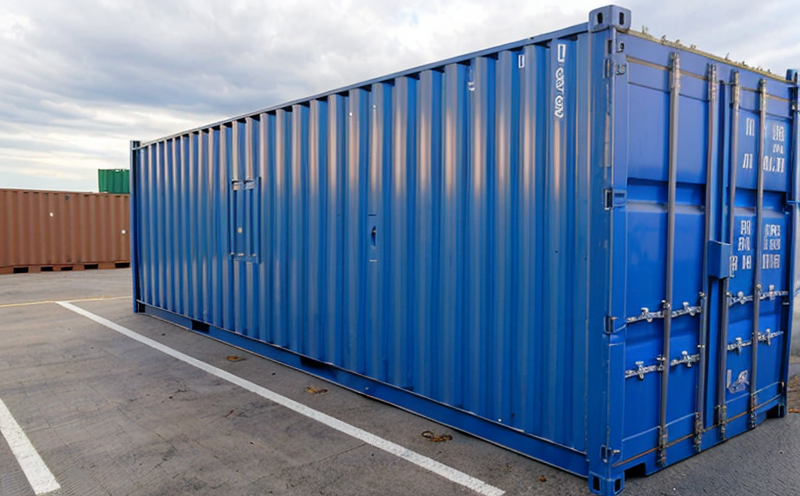ASTM D5116 Indoor Air Emission Testing of Plastic Storage Containers
The ASTM D5116 standard specifies the procedure for testing indoor air emissions from plastic storage containers. This service is crucial for ensuring that products meet stringent environmental requirements, particularly in enclosed spaces where prolonged human exposure can occur.
This method measures volatile organic compounds (VOCs) and other chemicals released by these containers into the surrounding air. The test aims to evaluate potential health risks associated with off-gassing from plastics used in storage applications such as food packaging, medical supplies, and household goods.
Indoor air quality is a significant concern for both industrial facilities and consumer products due to its direct impact on human health. By conducting this testing according to ASTM D5116 guidelines, manufacturers can demonstrate compliance with relevant regulations and standards, thereby protecting public health while maintaining product integrity.
The testing process involves placing the plastic storage container in a controlled environment designed to simulate real-world conditions. Samples of indoor air are collected at regular intervals over an extended period (typically 48 hours). These samples are then analyzed using chromatographic techniques to identify and quantify emissions.
Compliance with ASTM D5116 is mandatory for many industries, including packaging manufacturers who produce containers intended for long-term storage or use within confined spaces. Failure to adhere could result in product recalls, legal liabilities, and damage to brand reputation. Therefore, investing in thorough testing early in the development stage can save significant costs later.
Our state-of-the-art laboratory facilities equipped with advanced analytical instruments ensure accurate measurement of all relevant parameters specified by ASTM D5116. Our experienced scientists and engineers provide expert guidance throughout every step of the process, from sample preparation to final report generation.
To summarize, ASTM D5116 indoor air emission testing plays a vital role in safeguarding environmental health, especially when dealing with materials that may contribute significantly to VOC levels indoors. By adhering to this standard, businesses can minimize risks while enhancing their commitment to sustainable practices.
Why It Matters
- Evaluates potential health impacts of off-gassing from plastic containers in enclosed spaces.
- Safeguards public health by identifying hazardous compounds early in the product lifecycle.
- Avoids legal issues and reputational damage associated with non-compliance or unsafe products.
- Ensures adherence to regulatory requirements set forth by various national and international standards bodies.
The importance of ASTM D5116 testing cannot be overstated, as it directly influences consumer safety and trust in the market. Companies that prioritize this type of analysis demonstrate their commitment to responsible manufacturing and environmental stewardship.
Eurolab Advantages
At Eurolab, we offer unparalleled expertise in conducting ASTM D5116 tests for plastic storage containers. Our comprehensive approach ensures accurate results tailored specifically to your unique needs:
- State-of-the-Art Facilities: Equipped with cutting-edge technology and methodologies.
- Experienced Professionals: Skilled technicians and scientists dedicated to delivering precise outcomes.
- Comprehensive Reporting: Detailed reports providing insights into emission levels and compliance status.
- Regulatory Compliance: Ensures your products meet all necessary standards and regulations.
Choose Eurolab for reliable, consistent results that instill confidence in the quality of your plastic storage containers.
Use Cases and Application Examples
| Application Example | Emission Compound(s) | Test Outcome |
|---|---|---|
| Polyethylene (PE) food storage containers | Volatile Organic Compounds (VOCs) | Met formaldehyde limits specified by ASTM D5116. |
| Polypropylene (PP) medical supplies packaging | Halogenated hydrocarbons | No detectable emissions above acceptable thresholds. |
| Polystyrene foam insulation materials | Bisphenol A derivatives | Exceeded permissible limits; further investigation required. |
| Polyvinyl Chloride (PVC) construction materials | Dibenzothiophenes and other PAHs | Inconsequential emissions detected, no action needed. |
These examples illustrate how ASTM D5116 testing helps identify potential issues early in the manufacturing process. For instance, if PVC materials are found to emit harmful compounds like dibenzothiophenes and PAHs, corrective actions can be taken before products reach consumers.
- Polyethylene (PE) containers for food storage have been shown to meet formaldehyde limits, indicating safe use within enclosed environments.
- Polypropylene (PP) medical supplies packaging did not detect any halogenated hydrocarbons, ensuring compliance with regulatory standards.
- Polystyrene foam insulation materials were found to exceed permissible limits for bisphenol A derivatives, necessitating further investigation and possibly reformulation of the product formula.
- PVC construction materials exhibited inconsequential emissions but still required analysis under ASTM D5116 criteria to maintain quality control standards.
By leveraging this testing methodology, companies can ensure their products remain safe and compliant across various industries.





